If you’re thinking of purchasing a diamond but the clarity factor has you puzzled, you’ve come to the right place. After all, understanding diamond clarity isn’t just for gemologists – it’s the key to unlocking the true beauty and value of your next diamond purchase.
In this comprehensive guide, you’ll discover what diamond clarity really means, why it’s an important quality to get right, and how it fits into the grand scheme of the 4Cs of diamonds.
Additionally, we’ll provide you with some practical tips on how to choose the perfect diamond within your budget and a helpful FAQ section. So without further ado, let’s get right into it.
What Is Diamond Clarity?
As one of the 4Cs of diamonds, along with cut, colour, and carat weight, diamond clarity is a measure of how many ‘inclusions’ or imperfections are present in a diamond.
These inclusions are naturally occurring features that form under the intense heat and pressure when carbon transforms into a diamond. They include crystals, feathers, clouds, and graining, and can significantly impact a diamond’s appearance and value.
Clarity is evaluated on a scale established by the Gemological Institute of America (GIA), ranging from ‘Flawless’ (no inclusions or blemishes visible under 10x magnification) to ‘Included’ (inclusions visible to the naked eye).
This scale helps gemologists categorise a diamond’s clarity based on the size, number, location, and visibility of these imperfections.
Importance of Diamond Clarity in the 4Cs
The 4Cs collectively shape a diamond’s unique character. Because it assesses the presence of inclusions and blemishes in a diamond, clarity directly impacts a diamond’s transparency and has a small effect on its brilliance.
Stones with higher clarity grades generally command higher prices due to their rarity. However, many inclusions are microscopic and have minimal impact on a diamond’s brilliance. Ultimately, balancing clarity with the other diamond qualities is key to choosing the perfect diamond that resonates with both aesthetics and value.
The Evolution of Diamond Clarity Grading
The practice of grading diamonds based on clarity is not merely a modern invention but a complex evolution that has shaped the very core of the diamond industry. This journey began in the early 20th century, marking a significant turning point in gemology.
As the industry grew, the need for a standardised and universally accepted grading system became apparent. Various grading systems were experimented with, each contributing to the understanding of how inclusions and blemishes affect a diamond’s beauty. Renowned institutions like the Gemological Institute of America (GIA) played a pivotal role in refining these systems, leading to the standardised scales used today.
The GIA Diamond Clarity Scale Explained
The Gemological Institute of America (GIA) is a globally recognised authority in gemology, and their diamond clarity scale is a standard in the industry. Understanding this scale is essential for anyone looking to buy or sell diamonds, as it provides a clear and consistent way to evaluate a diamond’s clarity.
The GIA Diamond Clarity Scale is a grading system that categorises diamonds based on the presence and visibility of internal and external imperfections, known as inclusions and blemishes. The scale ranges from ‘Flawless’, where no inclusions or blemishes are visible under 10x magnification, to ‘Included’, where inclusions and/or blemishes are noticeable to the naked eye.

Clarity Grades Explained
It can be difficult to understand what a diamond will actually look like at each clarity grade. In this section, we’ll look at each, including a magnified image of a real diamond.
FL: Flawless
It is the highest rated clarity grade that even if a skilled grader inspects it 10 times larger, it can not confirm any inclusions, flaws, etc., both inside and outside. It is said that many people in the jewelry industry have never seen it, and it is an extremely rare grade that is rarely distributed in the general market.

For round brilliant diamonds, “Flawless Clarity, D Color, VVS1 Clarity” is the perfect combination, and for large diamonds, it is recognised as a special grade with asset value. Both loupe and microscope inspections are required for grade evaluation.
Since flawless has extremely few defects, it is difficult to identify individuals due to flaws. Therefore, the most reliable way to confirm the identity of a diamond and a certificate is to confirm the girdle stamp number with a laser beam.
- Natural limited to girdle width (small edges of rough diamonds left on the surface of polished diamonds)
are almost invisible to the naked eye. However, if Natural flattens or dents the girdle contours, it will affect the grade. - Extra facets on the pavilion that are not visible face-up (extra cut faces not required for cut style)
- Laser engraving that can be judged not to have entered the inside when observing face-up at 10x magnification
- Internal graining (growth line *) that is not reflective, does not take on white or other colors, and does not impede transparency.
IF (Internally Flawless)
It is a quality that can confirm no defects inside and very fine scratches on the outside. It is the highest quality clarity grade on the market as well as Flawless. Even if a skilled grader is magnified 10 times, no defects such as inclusions can be found inside. Checking IF level surface defects is very difficult even with a skilled grader.

The difference from flawless can is at the microscope level, and the only grades that cannot be confirmed with inclusion inclusions at 10x are flawless and IF.
Due to the quality with extremely few defects, the identity is confirmed by the girdle confirmation number etc. like Flawless.
Since the scratches on the surface of the IF are very slight and can only be confirmed with a microscope, there is no description as an individual clarity feature in the certificate. Instead, the clarity characteristics section of the IF’s certificate will always include the comment “Minor Details of Polish”, “No blemishes are shown”.

VVS1: Very Very Slightly Included 1
Even if a skilled grader views the diamond at 10x magnification, it is extremely difficult to distinguish inclusions by face-up observation, and it can only be found by face-down.

VVS-class diamonds have few shortcomings, as it is difficult for even a seasoned grader to determine the exact criteria under normal circumstances. It is the highest class clarity grade with excellent quality in general distribution.
VVS2: Very Very Slightly Included 2
It is the second highest rating after VVS1 even in the evaluation that it contains only a very small amount of inclusions.

Even if a skilled grader is magnified 10 times, it is very difficult to recognize inclusions, etc., and it cannot be confirmed in a general environment.
VS1: Very Slightly Included 1
It is a quality with very few inclusions, and it is difficult to check inclusions etc. when a skilled grader is magnified 10 times.
It is difficult for the general public to see it with the naked eye, and even if it is magnified 10 times, it is difficult to recognise inclusions. Therefore, VS1 has a small amount of inclusions, but it is in a class that is evaluated as mild.

Typical inclusions are small inclusion crystals, small cracks and cracks, and small cloud inclusions (clouds).
VS class inclusions do not affect the beauty of the stone. It is a clarity grade that is comparable to the highest class, which is extremely excellent in quality that is generally distributed.
VS2: Very Slightly Included 2
It refers to the rating of the second highest evaluation after VS1 even in the evaluation that it contains a very small amount of inclusion.

It will be a little easier to check inclusions when a skilled grader is magnified 10 times, but it is difficult, and it is very difficult for the general public to recognize inclusions even if they are magnified 10 times. It’s difficult. It is an excellent clarity grade that cannot be confirmed with the naked eye, so it looks the same as the VVS class.
As you can see, grades up to VS2 do not contain inclusions that affect brilliance or are large in size and affect durability. Therefore, Brilliance Plus recommends VS2 or higher as the best grade.
SI1: Slightly Included 1
There are slightly clear inclusions, and the quality is relatively easy to find when a skilled grader magnifies 10 times.
The inclusion characteristics of normal SI1 are not visible to the naked eye unless they are magnified, and it is somewhat difficult for the general public to distinguish inclusions even when magnified 10 times.

As you can see, many SI1s have subtle differences that are indistinguishable from the higher-ranking clarity grades, and their appearance remains the same.
Therefore, it is a grade that has both reasonable price and sufficient quality. If you are not particular about VS quality, we recommend it as a quality with high cost performance.
SI2: Slightly Included 2
Even in the evaluation that there is a slightly clear inclusion, it refers to the second-ranked rating after SI1. When magnified 10 times, even the general public can check the inclusions relatively easily.

Also, in the SI2 class, it is often the case that defects cannot be confirmed when a slightly small diamond of 0.5 ct or less is seen with the naked eye, but inclusions may be rarely seen with the naked eye when the size is larger than that.
I1, I2, I3: Included
Defects such as inclusions and flaws can be easily seen with the naked eye on the face-up, which can seriously affect durability. Large inclusions and numerous inclusions affect the transparency and brilliance of diamonds.

Inclusions and Blemishes: A Detailed Exploration
Natural diamonds are formed deep within the Earth’s mantle under extreme heat and pressure. This intense process often leads to the creation of inclusions and blemishes within the diamond.
- Inclusions: These are internal characteristics, such as minerals, fractures, or cavities, trapped inside the diamond during its formation. They are a natural result of the diamond’s growth and can vary widely in size, shape, and visibility. While inclusions might be seen as imperfections, they are, in fact, natural fingerprints that make each diamond unique. Understanding the types, sizes, and locations of inclusions is vital in assessing a diamond’s clarity grade.
- Blemishes: These are external imperfections on the surface of the diamond, such as scratches, nicks, or chips. Blemishes can occur during the diamond’s formation or be introduced during cutting and handling. Blemishes can affect the overall appearance of the diamond, but their impact often depends on their size and location.
Both inclusions and blemishes play a crucial role in determining a diamond’s clarity grade, which, in turn, affects its value. A diamond with fewer or smaller inclusions and blemishes is often considered more desirable. However, many of these characteristics are microscopic and may not affect the diamond’s appearance to the naked eye.
How Are Clarity Grades Determined?
Diamond clarity grading is a meticulous process that involves the careful examination of a diamond under 10x magnification. The grading process evaluates the size, nature, number, location, and relief of inclusions and blemishes.
- Size: The size of the inclusions and blemishes plays a significant role in the clarity grade. Larger inclusions are more likely to impact the diamond’s appearance and are, therefore, graded more harshly.
- Nature: This refers to the type of inclusion or blemish. Some inclusions, like fractures, may have a more significant impact on the diamond’s structural integrity, while others, like tiny mineral deposits, may be less concerning.
- Number: The number of inclusions and blemishes also affects the clarity grade. A diamond with several small inclusions may receive a lower grade than one with a single, more prominent inclusion.
- Location: The location of the inclusions and blemishes is crucial. Those near the centre or along prominent facets may be more visible and negatively affect the grade, while those near the edges might be less noticeable.
- Relief: Relief refers to how noticeable an inclusion or blemish is against the background of the diamond. High relief means the inclusion is more visible, while low relief means it blends more with the diamond’s overall appearance.
By carefully evaluating these five factors, gemologists can assign a clarity grade that accurately reflects the diamond’s unique characteristics. This grading process ensures consistency and helps buyers understand what to expect from a particular diamond.
Different Types of Inclusions in Diamond Clarity
Here are the most common clarity inclusions that can be found within a diamond.
- Cloud: A cloud is a group of tiny inclusions that are too small to be seen individually but together create a hazy or cloudy appearance. Clouds can affect the transparency of the diamond and may reduce its brilliance.
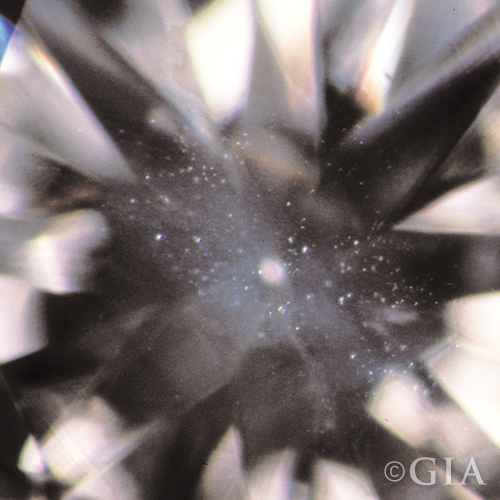
- Graining: Graining refers to internal or external lines, often irregular, that can appear within the diamond. They are usually caused by irregularities in the crystal structure. While often invisible to the naked eye, heavy graining can impact the diamond’s appearance.
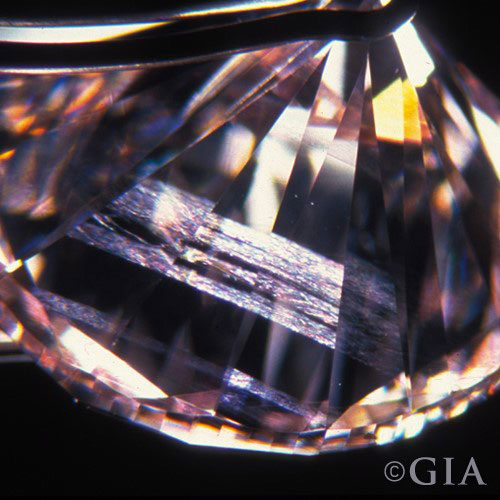
- Cavity: A cavity is an opening or void within the diamond, often resulting from a crystal that was present during the diamond’s growth but later dissolved. Cavities can trap dirt and oils, making them more visible and potentially affecting the diamond’s beauty.
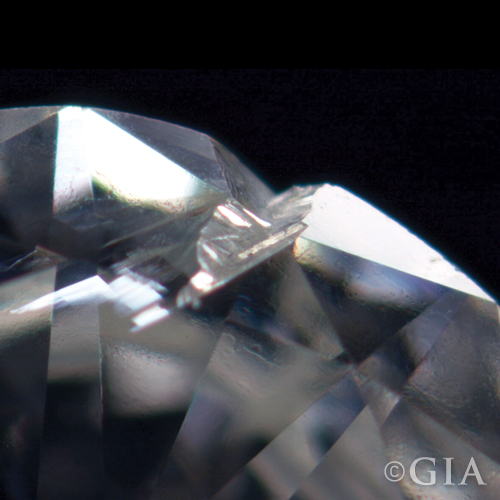
- Feather: A feather is a type of fracture within the diamond. It can look like a thin white line or a crack, and its appearance can vary depending on the angle of viewing. Feathers can affect both the appearance and durability of the diamond, especially if located near the edge where they might cause chipping.
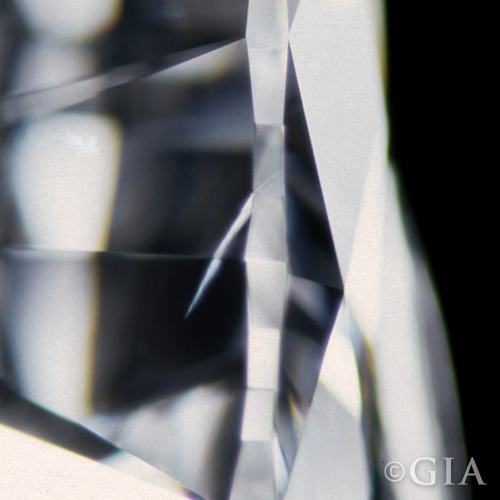
- Crystal: Sometimes, other minerals are trapped inside the diamond during its formation. These are known as crystals and can be of various sizes and colours. Depending on their size and location, they may or may not be visible without magnification.
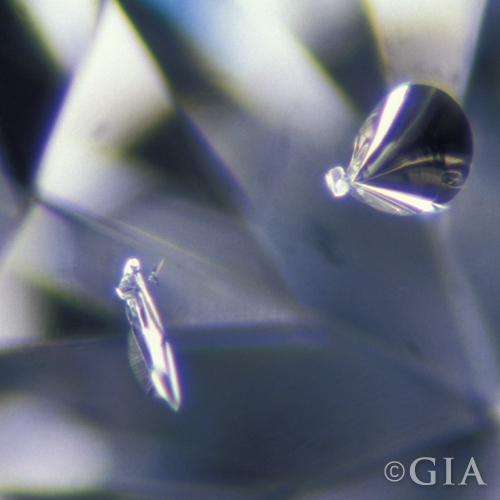
- Pinpoint: A pinpoint is a tiny crystal that looks like a small dot under magnification. While usually insignificant individually, a cluster of pinpoints can form a cloud and affect the diamond’s clarity.

- Knot: A knot is an included diamond crystal that reaches the surface of the polished diamond. It can sometimes be seen with the naked eye and may affect both the appearance and structural integrity of the diamond.

- Twinning Wisps: These are series of inclusions that form in a twinned diamond, where two separate crystal structures grow together. Twinning wisps can be complex and include clouds, crystals, and feathers.
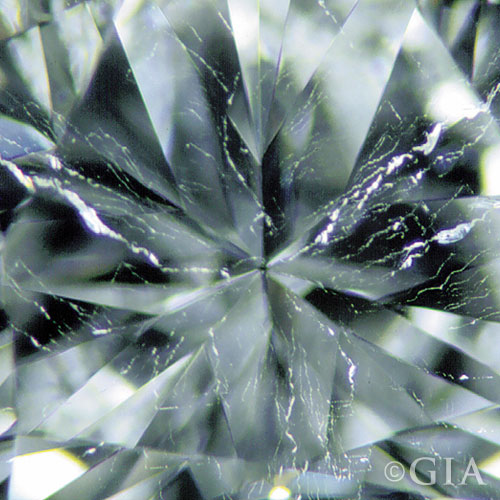
While some inclusions may have minimal impact on appearance, others can significantly affect a diamond’s beauty and value. Being acquainted with the different types of inclusions allows for more informed decisions and a deeper appreciation of the natural artistry within each diamond.
How Clarity Affects the Beauty of the Diamond
The clarity of a diamond is not just a technical aspect to be evaluated by gemologists. It plays a vital role in the overall beauty, brilliance, and value of the diamond. Here’s how clarity interacts with these essential aspects:
Clarity and Brilliance
At most clarity grades, the inclusions are so small that it doesn’t actually affect a diamond’s brilliance. However, significant inclusions can obstruct the light’s path as it enters and exits the diamond, diminishing its brilliance.
How Clarity Affects Sparkle and Appearance
- Inclusions and Light Reflection: Inclusions can disrupt the flow of light within the diamond, leading to less sparkle and brilliance. The more noticeable the inclusions, the more they may diminish the brilliance of a diamond.
- Blemishes and Surface Appearance: Surface blemishes can also affect the appearance of a diamond, especially if they are located on or near the table where they might be more visible.
Clarity and visible inclusions
While clarity doesn’t have a huge effect on the sparkle of a diamond, it can definitely affect its beauty if the inclusions are easily visible.
To demonstrate, we’ll include a 1-carat, G-colour, excellent cut diamond with three different clarity grades: IF, VS2, and SI2.
Even in this zoomed-in image, it is impossible to see any inclusions or blemishes in this IF diamond:
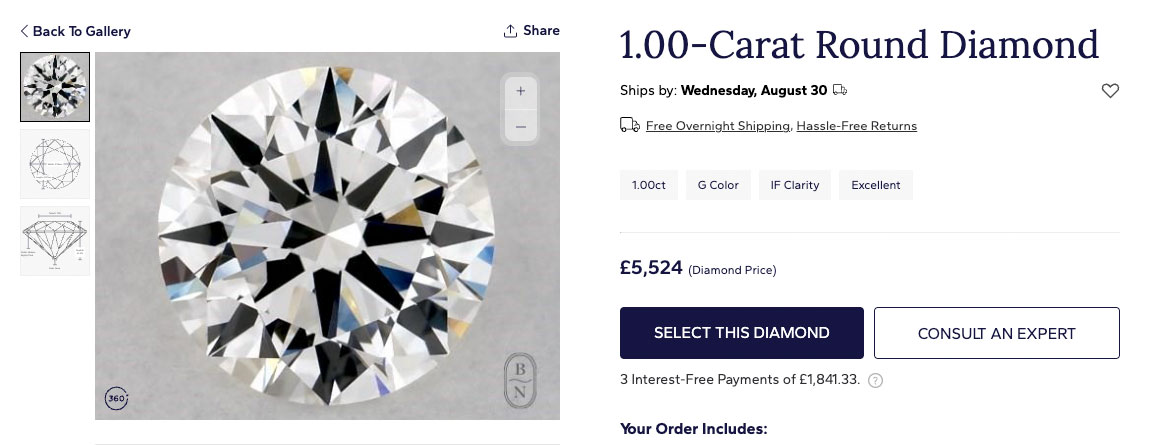
With the VS2 clarity diamond below, inclusions are still impossible to see, although there could possibly be some surface-graining visible.
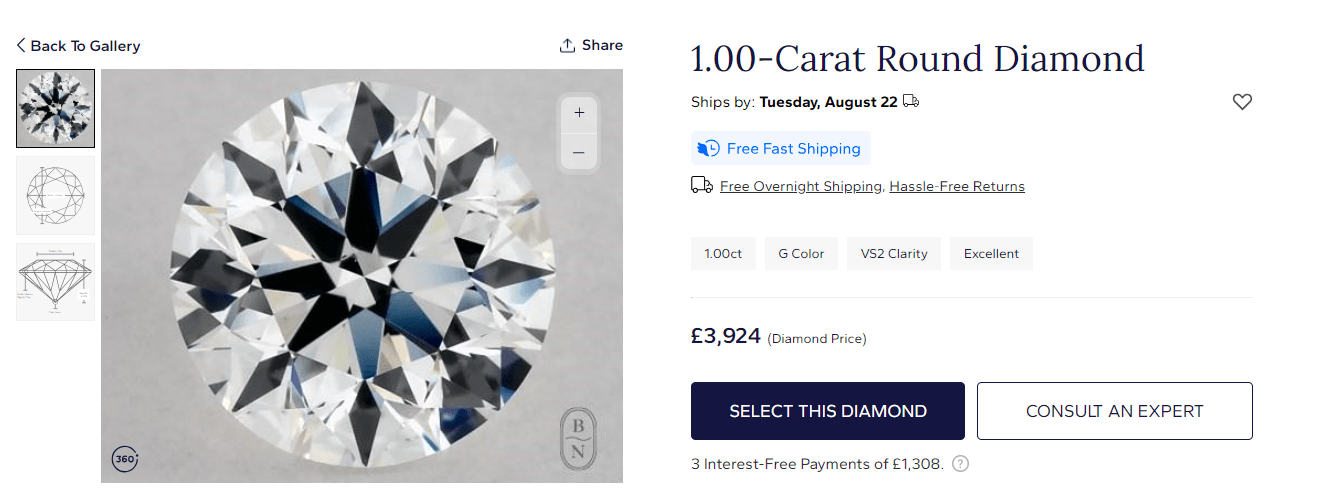
This could require some extra investigation, but would be impossible to see with the naked eye.
Lastly, in the SI2 clarity diamond below, the inclusions are easy to see – there are ‘twinning wisp’ inclusions across the table of the diamond:

These would also be visible when viewed with the naked eye, although as they are light in colour, they would be less visible than the inclusions on some diamonds that have been graded SI2.
Clarity and Price
Diamonds with fewer inclusions are both more rare and more beautiful, which results in higher prices. However, clarity should be considered in conjunction with other factors, like cut, colour, and carat weight. A balanced approach can lead to a beautiful diamond that offers excellent value for money.
As you can see in the examples in the previous section, the price of a 1 carat, excellent cut, G colour round brilliant diamond will vary significantly depending on the clarity grade.
| Diamond clarity | Diamond Price |
|---|---|
| Internally Flawless | £5,542 |
| VS2 | £3,924 |
| SI2 | £1,900 |
One thing to consider when you look at these prices is that while the SI2 is noticeably included, the VS2 is not. The VS2 diamond would look exactly the same to the naked eye once it has been mounted into a diamond ring.
Why diamonds with fewer inclusions are more valuable
Many rough diamonds have defects in appearance such as inclusions and flaws, so when the diamonds are being created, the diamond ‘cutters’ try to avoid the inclusions to produce a final stone that is as close to flawless as possible.
As a result, a large proportion of the original rough diamonds ‘yield’ (the weight) can be lost as sections with severe inclusions are discarded.
However, on the other hand, since no two diamonds have exactly the same inclusions in the exact same place, the presence of inclusions is a testament to the nature of the diamond and the originality of the diamond. Some people therefore consider a diamond’s pattern of inclusions as akin to a person’s fingerprint – this is especially true as it can make identifying whether a diamond is actually yours easier.
Clarity and Diamond Shape
Different diamond shapes can influence how clarity is perceived. Some shapes are more forgiving of inclusions, while others may highlight them.
How Different Diamond Shapes Impact Clarity Perception
- Round Diamonds: The sparkle that brilliant cut round diamonds generates often hides inclusions well, making them less noticeable.
- Fancy Shapes: Some fancy shapes, like emerald or Asscher cuts, have large, open facets that might make inclusions more visible.
Let’s compare a diamond with a fancy shape, like emerald, with a round diamond of the same carat weight and clarity.
On the SI1 round brilliant diamond below, there are some significant inclusions under the table:
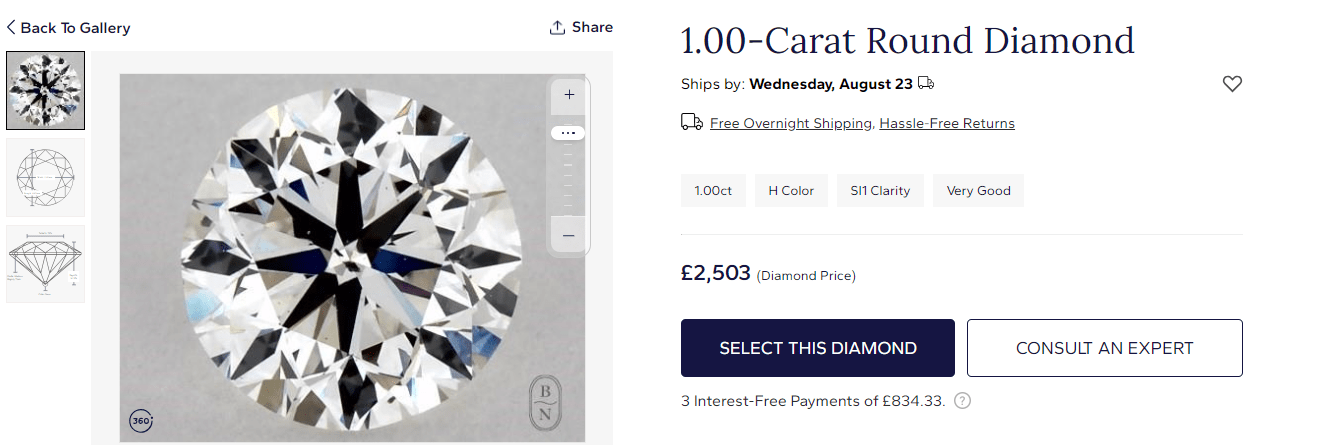
However, these inclusions are difficult to see in the image due to the facets. When this diamond is seen in real life, the brilliance and scintillation would make the inclusions difficult to see.
However, if we look at an SI1 emerald cut diamond with inclusions under the table, they are much easier to see:
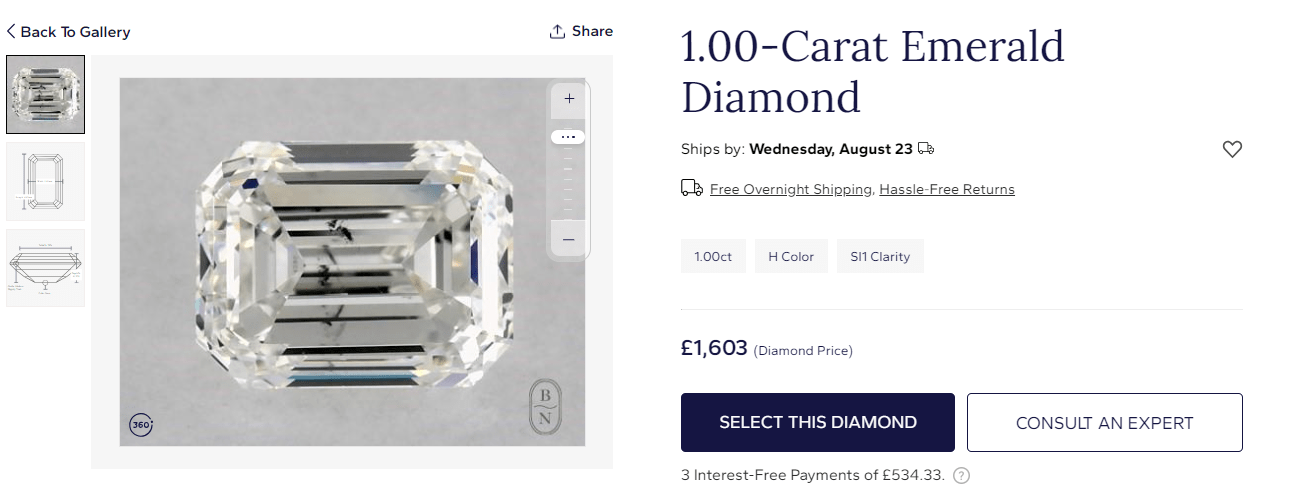
For this reason, it can be a good idea to select a higher clarity grade if you are considering a diamond shape that doesn’t sparkle as brilliantly as a round diamond.
Selecting the Best Diamond Clarity for Your Budget
Understanding the different clarity grades can help you make a satisfying purchase that offers excellent value for money. Let’s see how you can do just that.
Understanding Clarity Grades
A clarity plot is a map that provides a detailed visual representation of a diamond’s internal and external characteristics. It’s an essential tool in understanding a diamond’s clarity grade and the specific inclusions and blemishes that contribute to it. When you look at a clarity plot, you’ll see a top-down view and a profile view of the diamond, with various symbols representing different types of inclusions and blemishes.
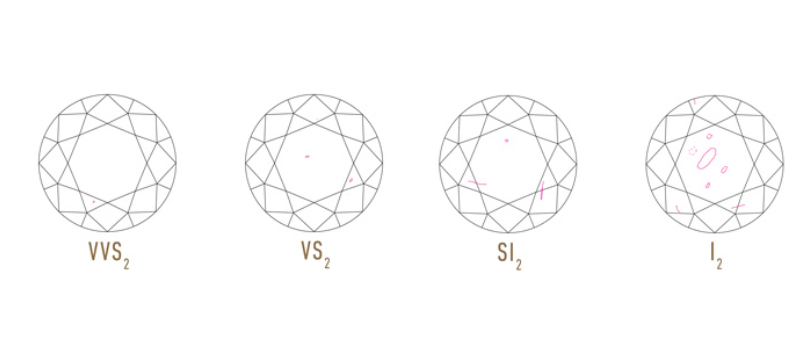
To read a clarity plot, start by identifying the symbols used. Each symbol represents a different type of inclusion or blemish, such as crystals, feathers, or cavities. The plot will also indicate whether these characteristics are inside (inclusions) or on the surface (blemishes) of the diamond.
Next, look at the location of these symbols on the plot. This will give you an idea of where the inclusions and blemishes are located within or on the diamond. Remember, the location of these characteristics can significantly impact a diamond’s appearance and value.
In essence, a clarity plot is a map that guides you through the unique landscape of a diamond’s clarity characteristics, helping you understand its unique beauty and value.
Tips for Buying the Best Diamond Clarity
Selecting the right clarity grade requires careful consideration and practical insights. Here are some valuable tips to help you find the perfect diamond within your budget:
- Don’t Overpay: Focus on cut quality and avoid overpaying for higher clarity grades that might not be noticeable to the naked eye.
- Understand the Clarity Grades: Familiarise yourself with the clarity grading scale and what it means for appearance and value.
- Know Your Budget: Define your budget and prioritise what matters most to you, such as cut quality or size.
- The “Two Inches Rule”: Most inclusions are not visible from a distance of two inches or more.
- Review the Diamond Closely: Carefully review diamonds for visible inclusions and seek expert opinions if needed.
- Consider the Whole Picture: Balance clarity with other diamond qualities, like cut, colour, and carat weight, to find a diamond that offers excellent value for money.
Conclusion: Making an Informed Diamond Purchase
Diamond clarity is not just a technical term, but an important aspect that shapes the diamond’s overall appeal and value. It refers to the presence of inclusions and blemishes within a diamond. Diamond clarity affects the diamond’s brilliance, appearance, and value, and it’s one of the 4Cs that determine a diamond’s quality.
The GIA Diamond Clarity Scale provides standardised grading, ranging from Flawless to Included. It’s essential to balance clarity with other factors like cut, colour, and carat weight if you want to buy a diamond that’s well-rounded.
Understanding diamond clarity and how it impacts the beauty and value of the diamond is essential for making an informed purchase, so we hope our guide got you more acquainted with this diamond quality.
The term “best” can be subjective, as it depends on individual preferences and budget. However, in terms of grading, Flawless (FL) Clarity is the highest clarity grade, where a diamond has no inclusions or blemishes visible under 10x magnification. It’s considered the best in terms of purity but it’s extremely rare and often comes at a premium price.
That being said, many buyers find that diamonds in the VS (Very Slightly Included) or SI (Slightly Included) range offer excellent value for money, appearing clean to the naked eye without the premium price of a Flawless diamond.
SI (Slightly Included) clarity can be a good choice for many buyers, depending on individual preferences and how the diamond is viewed:
– SI1 Clarity: Often appears clean to the naked eye, especially in smaller carat weights or specific shapes.
– SI2 Clarity: May have visible inclusions, especially in larger diamonds or certain shapes. Careful selection and expert guidance can still lead to beautiful choices in this grade.
SI clarity diamonds often offer excellent value for money, providing a beautiful appearance without the premium price of higher clarity grades.
Clarity does play a small role in a diamond’s sparkle, but it’s not the only factor:
– Higher Clarity Grades: Diamonds with fewer inclusions and blemishes often allow more light to pass through, contributing to more sparkle.
– Cut Quality: The cut of the diamond is the most critical factor in its sparkle. Even a diamond with lower clarity can sparkle brilliantly if it’s well-cut.
What appears most sparkly can vary from person to person. Viewing diamonds in different lighting conditions and seeking professional guidance can help you find what sparkles most for you.
